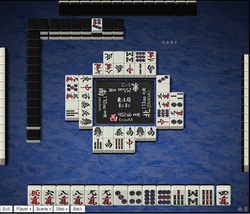Riichi Book 1
Riichi Book 1 is a "mahjong strategy primer for European players". Written by Daina Chiba, it is a free online guide written in English and is often cited as go-to source for game improvement among the Western player base. The material is aimed to help players learn the game beyond yaku and perhaps attain tokujou level status on the Tenhou ladder.
Tenhou.net
Tile efficiency

The third chapter of the book covers tile efficiency with an emphasis on maximization. Players need to understand that a hand can be broken down into basic blocks. Given various hand shapes, a hand during the process of development always have a number of waiting tiles to further progress the hand. Here, player must look to aim to reduce the shanten count. A lower shanten count reduces the number of waiting tiles. This only means the hand advances and requires fewer tiles to advance further. Once tenpai, the counts are minimized.
Tile groups
Tile groups can be broken down into two subcategories: sequential and triplets. Of the two, the former is the easier to complete by virtue of greater tile counts for completion. For every waiting pattern, there is a set number of waiting tiles. Ryanmen provide the greatest number of waiting tiles from using just two tiles. As for other shapes, players may need to consider the ability for the tile shape to be reformed. During the formation of a hand, players may upgrade isolated tiles into taatsu.
Tile versatility
Certain tiles are more versatile than others. This is due to the number ranges.
Tile closer to the terminals have fewer tiles, that can help improve the shape. Tiles 3-7 each can form taatsu using four tile types. Tiles 2 and 8 are reduced to needing any of three tile types. Terminals are limited to just two tile types in order to develop. The honor tiles are the most difficult as they are each reduced to their own type.
Furthermore, kanchan waits can be ordered by versatility. This stems from their ability to be reshaped and upgraded into ryanmen.
Pairs
All hands require paired tiles for completion. Then there is chiitoitsu, which is a collection of pairs. If a developing hand lacks a pair, then logically, the hand needs one. Of course, a hand could be tenpai on the pair, or tanki. However, as a wait, it is not an ideal one. If possible, a hand can be improved with a specific draw even when tenpai to produce a waiting pattern with a greater range to tile types.
The pair is a taatsu. Like any, they can be upgraded. In this case, a pair can become a triplet. Pairs are not often ideal, especially when more than one is in the hand. The weakest count of pairs falls on three, as efficiency gets hindered by the lower number of waiting tiles. A hand with four pairs at least has chiitoitsu as a consideration.